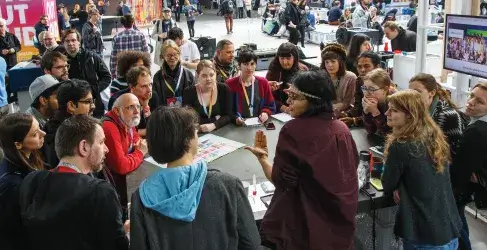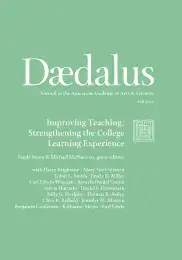
Becoming a Better College Teacher (If You’re Lucky)
This contribution is a narrative of how a professor attempted to improve as a teacher over time. The narrator noticed the need for improvement through teaching a new class badly, and learning that he had no reason to trust that he, or many others, were teaching other classes better. The contribution describes in some detail the steps he took, and continues to take, including observing colleagues, hiring a coach, reviewing videos of his classes, and participating in department workshops. There is no empirical evidence that he has improved, but the narrator provides some reasons for optimism.
Catalysts for Achieving Sustained Improvement in the Quality of Undergraduate STEM Education
Promoting excellence in undergraduate STEM (science, technology, engineering, and mathematics) education at major research universities is necessary to ensure that we have the STEM-literate workforce and general population required to propel the nation forward into the twenty-first century and beyond. This essay provides a brief contextual history of the Association of American Universities’ (AAU) effort to improve the effectiveness of undergraduate STEM education at member campuses and delineates the specific goals of this initiative. The essay then illuminates the essential role of the academic department and department chair in achieving long-lasting change and improving the quality of undergraduate education. It also discusses critical strategies and approaches for promoting the most effective methods for undergraduate STEM teaching and learning, with numerous examples from AAU member universities. The essay concludes with an acknowledgment of key challenges and opportunities that continue to face undergraduate education at research universities.
Expertise in University Teaching & the Implications for Teaching Effectiveness, Evaluation & Training
Universities face the challenge of how to teach students more complex thinking and problem-solving skills than were widely needed in the past, and how to teach these to a much larger and more diverse student body. Research advances in learning and teaching over the past few decades provide a way to meet these challenges. These advances have established expertise in university teaching: a set of skills and knowledge that consistently achieve better learning outcomes than the traditional and still predominant teaching methods practiced by most faculty. Widespread recognition and adoption of these expert practices will profoundly change the nature of university teaching and have a large beneficial impact on higher education.
Access the online appendices here.
Together and Alone? The Challenge of Talking about Racism on Campus
Higher education institutions are among the few places where people of different racial, cultural, and socioeconomic backgrounds can engage with each other in more than just a superficial way, providing students a unique opportunity to develop the skills needed to function effectively in a diverse, increasingly global world. Whether students develop this capacity will depend in large part on whether the institution they attend has provided structures for those critical learning experiences to take place. But what form should such learning experiences take? This essay argues that positive cross-racial engagement may require both structured intergroup dialogue and intragroup dialogue opportunities to support the learning needs of both White students and students of color in the context of predominantly White institutions.
“Now Is the Time”: Civic Learning for a Strong Democracy
Cultivating citizens for American democracy has historically been a key purpose of higher education, yet today’s college students are in contact with more divergent worldviews, increasing demographic diversity sometimes accompanied by fear of “the other,” and resulting conflict in policies amid rising inequality. Now is the time to recenter civic learning within and across all institutions and disciplines, as well as undertake more critical approaches to this work in terms of pedagogy that prepares students for a diverse and unequal society. Colleges’ collective efforts have already resulted in critical community engagement, curricula reform, and better ways of articulating and assessing civic learning practices. Extending civic learning to reflect how we teach will result in more engaged citizens capable of understanding differences, conflict as an opportunity to learn, and community-building processes characteristic of a strong democracy.
The Future of Undergraduate Education: Will Differences across Sectors Exacerbate Inequality?
This essay looks at how different sectors of U.S. higher education are funded, the students they serve, and the outcomes they deliver for those students. It raises serious policy questions about whether the distribution of public funds across this highly segmented industry both reflects and contributes to growing inequality in this country. It also asks whether recent trends in educational innovation and the impact of technology innovation in higher education will exacerbate or ameliorate that inequality. While the evidence is disturbing, the essay concludes optimistically. The past, it suggests, need not be prologue in higher education. The path forward for our industry, while highly constrained, can as yet be shaped through thoughtful, conscious, and analytically driven choices at individual, institutional, and state and federal policy levels.
CREATE a Revolution in Undergraduates’ Understanding of Science: Teach through Close Analysis of Scientific Literature
The teaching of science to undergraduates aligns poorly with the practice of science, leading many students to conclude that research is boring and researchers themselves are antisocial geniuses. Creativity, a key driver of scientific progress, is underemphasized or ignored altogether in many classrooms, as teaching focuses on the complex integrated concepts and voluminous amounts of information typical of STEM curricula. Faculty, largely untrained in science education per se, teach largely as they were taught, through lectures based in textbooks. This situation could change, and students’ understanding of research practice could be fostered relatively easily, if faculty began teaching classes focused on the journal articles they read in their professional lives. In this essay, I outline a novel scaffolded approach to guiding students in a) deciphering the complexities of scientific literature and b) the process of gaining new understanding of who scientists are, what they do, how they do it, and why.
The False Dichotomy between Academic Learning & Occupational Skills
What distinctions are there between vocational (career and technical) education and academic learning in college? In this essay, we compare broad academic and vocational program goals, embodied skills, tasks, and jobs, with a focus primarily on community college students. There is considerable overlap between the two types of education, so a separation of tracks presents a false dichotomy. In addition, vocational certificates, which often have little academic content, have attracted attention lately as a path to good jobs. New evidence indicates that degrees offer more substantial advantages than certificates in the labor market. We argue for an alternative framework for thinking about the optimal accumulation of skills in college. Rejecting the traditional distinction between vocational education and academic learning, we posit that educational paths are best understood as accumulations of general education followed by terminal work-related education. We label this the Gen-Tech framework and consider its explanatory power and implications for colleges and students.
Mitigating Ethical Costs in the Classroom
Students from disadvantaged backgrounds often find that succeeding on the path of upward mobility through education requires that they distance themselves from their communities, family, and friends. This distancing often involves the weakening or loss of aspects of their lives that are meaningful and important to them: their relationships with family and friends, their connection to their communities, and their sense of identity. These goods, by their nature, are not ones that are easily replaced. Yet their loss can be mitigated by the development of new relationships and new communities. In this essay, I argue that colleges and universities have an obligation to facilitate the mitigation of these costs for students from disadvantaged backgrounds. Doing so, however, is not as simple as it might seem. These students often feel alienated from campus life outside of the classroom and many do not even attend residential colleges. These two factors suggest that universities and professors will need to take more seriously the classroom as a central site for giving students from disadvantaged backgrounds opportunities to enter into new relationships and find new communities.
Financial Constraints & Collegiate Student Learning: A Behavioral Economics Perspective
Gaps in college completion persist between low- and high-income students. These disparities can be attributed in large part to a lack of college affordability and information asymmetries about the process of accessing financial assistance as well as other campus-based resources and supports. While substantial policy investments have been made to address these inequalities, such as expanded financial aid programs and increased investments in college advising, these programs are not always fully utilized by students who might benefit from them. In this essay, we apply a behavioral economics perspective to examine how financial constraints affect students’ navigation of the complex processes–financial, academic, and otherwise–required to succeed in American higher education. We conclude with a discussion of evidence-based behavioral strategies that policy-makers and educators can draw on to proactively mitigate these behavioral obstacles and improve student success.
Toward a 2.0 Compact for the Liberal Arts
New demands on learning coupled with new concerns about a changing world have resulted in a new focus on what constitutes a durable learning experience in a liberal arts setting. While the noise of a crisis in the liberal arts can be distracting at times, what we learn is that different types of schools continue to answer the question of why the liberal arts remain an effective educational option. This essay argues that they are only beginning to address what is durable and adaptable about the liberal arts in the face of automation. While many have endorsed the LEAP (Liberal Education and America’s Promise) framework developed by the American Association of Colleges & Universities, which called for the liberal arts to be in the nation’s service, the original framework did not fully anticipate the rate, scale, and far-reaching impact of automation. What is needed is a liberal arts 2.0, one that prepares learners to become robot-proof in a world in which many will find themselves with robotic helpers.
The Human Factor: The Promise & Limits of Online Education
The idea that online learning might revolutionize higher education, lowering the cost of high-quality learning opportunities for students with limited access to traditional higher education, follows similar hopes for earlier technologies, including radio and television. If such a revolution is to come, it is still far from a reality. Strong evidence indicates that students with weak academic backgrounds and other risk factors struggle most in fully online courses, creating larger socioeconomic gaps in outcomes than those in traditional classroom environments. The central problem appears to be the lack of adequate personal interaction between students and instructors, as well as among students. Hybrid learning models do not exhibit the same problems and there is potential for online learning to develop strategies for overcoming these difficulties. Meanwhile, narrowing gaps in educational opportunities and outcomes requires considerable skilled human interaction.
